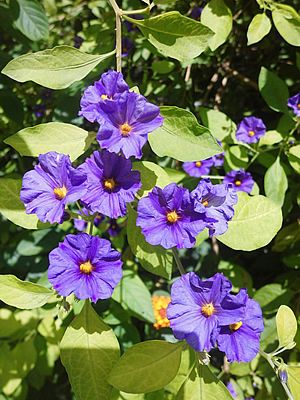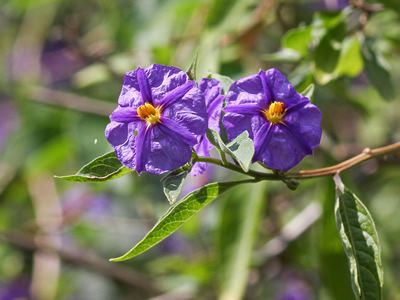The Blue Potato Bush (Lycianthes rantonnetii) is a perennial, highly branched shrub with ornamental foliage and flowers. Native to Brazil, Paraguay, Argentina, and Bolivia, it reaches about two meters in height and width, displaying a beautiful rounded shape. The leaves are oval to elliptical, acuminate, simple, entire, alternate, and either bright green or variegated with white.
During summer, numerous trumpet-shaped flowers emerge, featuring a prominent golden-yellow center and fused petals in shades of blue or purple, depending on the variety. These delicately scented flowers attract pollinators such as butterflies and hummingbirds. The subsequent fruits are small, globular berries, heart-shaped at the base, orange or red, appealing to birds but toxic to humans and domestic animals.

A graceful shrub, perfect for creating flowering hedges, topiaries, and even as a climber. The Blue Potato Bush can be planted in groups, rows, or as a standalone, highlighting feature. You may train it as an informal bush, or shape it in various forms, as it tolerates frequent pruning.
Pruning should be done in winter, after flowering, and should not be drastic, limited to about a third of the branch length. It exhibits rapid to moderate growth. If the lower branches are removed, it transforms into a delicate small tree. It can also be planted in pots and planters.
The Blue Potato Bush should be cultivated in full sun or partial shade, in fertile, drainable soil, enriched with organic matter, and watered regularly. Suitable for tropical and subtropical climates, it does not tolerate intense cold. It also thrives in coastal regions with salinity, provided it is sheltered from strong winds.
For a dense shape and intense flowering, it is advisable to plant it in full sun. In partial shade, it blooms less intensely and tends to develop a loose, informal foliage. Fertilize during the growth months, preferably with slow-release fertilizers at a 10.10.10 (NPK) ratio. Propagation is through cuttings of semi-woody branches.


